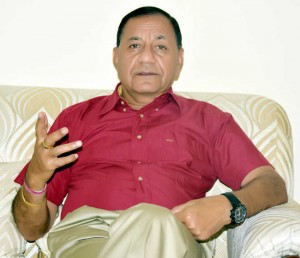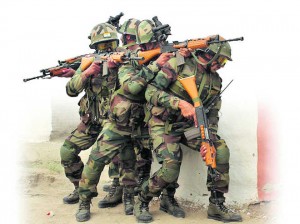Published in IDSA on 06 Oct 2017
IDSA Comment
The recent standoff at Doklam had raised genuine concerns about the situation escalating, given that the opposing troops stood ‘eye ball to eye ball’ for over 10 weeks. While the crisis has been defused for the time being, the probability of a future flare up cannot be ruled out. Post the disengagement, Chinese troops have fortified their positions in the Doklam Plateau with the declared intent of resuming the road construction activity at an appropriate time. The military build-up, which had been undertaken by the two sides in the wake of the crisis, remains in place. The current period of lull is, therefore, a tactical pause. In all prudence, Doklam should be taken as a nudge to initiate a holistic strategic review.
There is an old adage that “the longer you look back, the farther you can look forward”. Chinese leaders have a good understanding of their nation’s history and are known to make comparisons between the present and the past. Zhou Enlai had famously said “diplomacy is continuation of war by other means”, morphing the famous maxim by Clausewitz. Doklam was a well-calibrated small team action aimed at changing the status quo on the ground but with overarching strategic ramifications. The People’s Liberation Army (PLA) will make further moves on the ground only after the issue has been well deliberated by the Communist leadership.
After being appointed as ‘First Lord of Admiralty’ in 1911, Winston Churchill wrote a memorandum to his cabinet colleagues in which he stated that “Preparation for war is the only guarantee for preservation of wealth, natural resources and territory of the state.” To this end, he identified three key areas; probable dangers, history’s lessons and employment of war material. Interestingly, these guiding tenets are relevant to this day in the Indian context as well.
Probable Dangers
According to Graham Allison, the preeminent geostrategic challenge of the era is not violent Islamic extremism or resurgent Russia but the impact of China’s resurgence. Lee Kuan Yew had observed that the sheer size of China’s displacement meant that the world has to find a new order. Hence, when China cautions Japan to get used to its actions in the East China Sea and India to prepare for more Chinese roads in Doklam, these should not come as a surprise.
Through its assertive behaviour and expansionist approach, China has pursued the strategy of encroachment – ‘nibble and negotiate’ – evident from its actions both along its land borders and maritime frontiers. This is in consonance with the Chinese culture of maintaining a peaceful periphery by keeping the neighbourhood subdued. The Chinese are averse to any challenge or competition. A lonely power, China has optimally used its two allies – Pakistan and North Korea – to serve its strategic interests in the Indian subcontinent and the Korean Peninsula. With the deepening Chinese economic engagement with Pakistan as part of its global outreach, the nexus between the two countries is set to strengthen further.
Given the exponential accretion in China’s Comprehensive National Power (CNP), there is a marked shift from its earlier strategy enunciated by Deng Xiao Ping – ‘to bide for time and maintain a low profile’ till the completion of peaceful rise. Now, President Xi Jinping has emerged as an all-powerful ‘Fifth Generation’ leader whose China dream – fuxing (restoration)– envisions a “powerful and prosperous China”, symbolic of its past grandeur. In the quest to shape a ‘Sino-centric global order’, China seeks a unipolar Asia and a bipolar world. Mega projects like the Belt-Road Initiative (BRI) and Maritime Silk Route launched at Xi’s behest are means of power projection, designed to catapult China into the superpower league.
Xi has accorded high priority to defence modernization, an important component of CNP. Consequently, the PLA is in the midst of path breaking reforms to emerge as a modern military that is capable of winning “limited war under informationised conditions”. To this end, the Central Military Commission (CMC), the highest military body, has been reorganized. All the members of the CMC are senior most PLA Generals, including General Chang Wanquan who has been the Defence Minister since 2012. The massive infrastructure development on the borders aims to overwhelm the adversary with sheer speed and shock action. While a major conflict with India is not in China’s larger interest, it will keep up the pressure astride the Line of Actual Control (LAC) through pre-emptive tactical actions.
Historical Perspective
An analysis of past skirmishes along the border reveal a definite pattern. Mao initiated the 1962 War when he was under serious criticism post the disastrous ‘Great Leap Forward’. The Nathu La Incident in 1967 coincided with an intensely turbulent phase of the ‘Cultural Revolution’. The Sumdurong Chu crisis in 1987 synchronised with the 13th Party Congress. The standoff in the area of Depsang Plateau in April 2013 preceded the visit of Chinese Prime Minister Li Keqiang. The face off in Chumar in September 2014 happened during President Xi Jinping’s visit to India. Doklam was triggered in mid-June just before Prime Minister Modi’s visit to the US. The timing of the Doklam crisis may also have some connect with the 19th Party Congress due in mid-October 2017. China’s diplomatic moves to defuse the situation at Doklam were primarily to prevent the derailment of the BRICS meeting which would have severely dented Xi’s image. It is evident that China’s internal dynamics have definite linkages with incidences on the border. Beijing has repeatedly resorted to military force against neighbours to achieve political objectives.
Employment of war waging material
In an era of ‘limited wars’, defining lines between strategic and tactical objectives stand blurred. Even small tactical incidents have strategic implications, wherein it is not unusual for the top leadership to willy-nilly get involved, Doklam being a case in point. In a limited war scenario, it is not total force ratios that are critical. What is crucial is the quantum of combat potential that can be brought to bear in an integrated manner at the point of decision, in a telescopic time frame. A flat decision making structure and synergy are sine qua non in modern warfare. Thus, well-developed infrastructure particularly in forward areas is vital. China has gained a strategic edge in this regard. However, its vulnerability of fighting from exterior lines of communications can be optimally exploited.
Strategic Review
In the light of the aforesaid imperatives, a holistic strategic review is no more an option. This ought to be carried out over a wide spectrum and in a multi- dimensional manner with specific timelines. As the Chinese leadership believes in negotiating only with equals, India has to address the current state of asymmetry vis-à-vis China in right earnest. It is only a state of strategic equilibrium between the two countries that can pave way for meaningful dialogue and regional stability. Some of the key facets which deserve attention are enumerated below.
Firstly, as a part of grand strategy, India needs to rebalance in consonance with the geopolitical shift that is in the offing in the Indo-Pacific. To counter Beijing’s growing influence especially around the neighbourhood, New Delhi needs to shed its traditional policy of ambiguity. It has to be forthcoming to play a larger role in the region by aligning with strategic partners, namely the US and Japan, besides other friendly nations. In the process, India must push strongly for a multipolar global architecture to effectively thwart China’s designs.
Secondly, the enhancement of CNP as an integral component of national policy ought to be accorded highest priority to correct the prevailing imbalance. It entails sustaining a fast pace of economic growth, strengthening institutional mechanisms and the optimal utilisation of national resources.
Thirdly, as hard power is a vital component of CNP, enhancement of military capability is a critical imperative. So far, the process of military modernization has followed an ad hoc, incremental, approach in the absence of a well-defined national policy. This demands a strategic shift to make way for a transformational process in order to enable the Indian Army match the PLA. It entails dismantling bureaucratic gridlocks, abolishing service-specific organizational structures, sharpening the teeth-to-tail ratio, fast tracking the procurement cum acquisition procedures and leveraging technology. The consistent downward trend of defence expenditure as a percentage of GDP, which now stands at about 1.6 per cent, needs to be corrected.
Fourthly, there is an urgent need to prepare a ‘White Paper on National Defence’ which should clearly define the prevailing security environment, threat assessment and thrust of military modernization. Given the regional security dynamics, while major wars are unlikely, localised conflicts remain a possibility. The rapid advancement in technology has compressed time and space in addition to making battlefields non-linear. The traditional view of deterrence stands redefined by new concepts of ‘pre-emption’ and ‘prevention’ and these are being increasingly practiced by India’s adversaries.
Fifthly, it is ironic that we are yet to formulate a ‘Doctrine of Limited War’. This has to be a top driven process emanating from a National Defence Policy. Even the much talked of ‘two front scenario’ has varying interpretations between the three services. The current state of infrastructure stands out as a major impediment for the timely employment of combat power at the point of decision. The development of integrated and sustainable logistics is a pre-requisite for success in a limited conflict. The creation of super highways, freight corridors, forward airfields, strategic airlift capability and state of art communications set-up is the way forward.
Lastly, the concept of ‘border management’ requires a relook as the present system suffers from serious lacunae. There is an urgent need to have a single nodal agency to coordinate the functioning of the multiple organs involved in safeguarding India’s borders. Operational control on the Line of Control (LoC) and Line of Actual Control must rest with the Army. The operational capability of the Paramilitary Forces needs to be enhanced on priority basis. The mere enhancement of budgetary allocations without a coordinated security policy will not suffice. As the probability of face-offs and local skirmishes remains high, contingencies must be in place to deliver timely and calibrated responses. Disputed areas must be held in strength ab initio in order to prevent the adversary from presenting India with a fait accompli.
Given divergent national interests and overlapping strategic objectives, rivalry and competition is inherent in India-China relations. The vexed border issue coupled with the Tibet factor further add to the complexities. Hence, politico-diplomatic showdowns and standoffs on the border have to be accepted as a new normal. While sustained efforts to revamp the existing mechanisms of engagement remains a work in progress, there can be no laxity in defence preparedness. China respects strength and despises the weak. Defence and diplomacy being two sides of the same coin, it is boots on the grounds that determine the extent to which an envelope can be pushed at the negotiation table.
Maj Gen G G Dwivedi (retd) is former Assistant Chief of Integrated Defence Staff, has served as Defence Attaché in China, North Korea and Mongolia, and is currently Professor of International Studies at Aligarh Muslim University.
Views expressed are of the author and do not necessarily reflect the views of the IDSA or of the Government of India.






